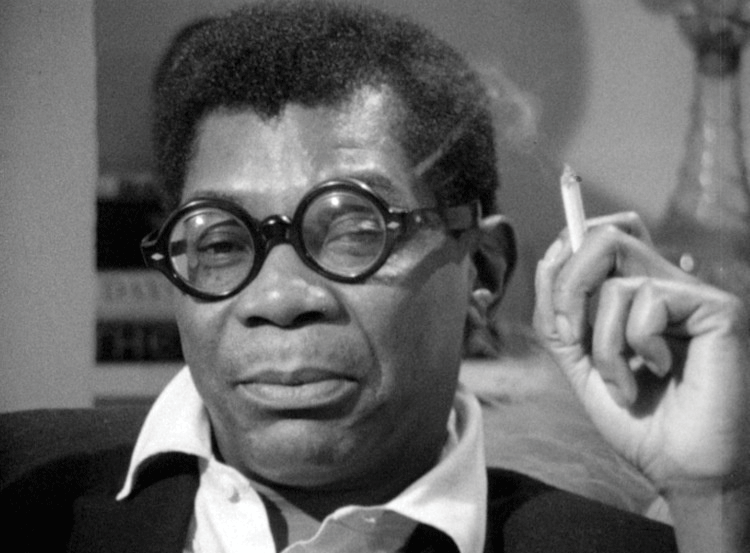Alternative Cinema: Portrait of Jason
Holliday’s life is put on display in this unique and memorable documentary that focuses on perception.
What does it mean to ask someone to reveal their true self? That’s what director Shirley Clarke requested of her friend, Jason Holliday, in 1962. As part of the weekly Alternative Cinema screening series, the documentary Portrait of Jason was shown in Golden Auditorium at 7 p.m. on Tuesday, September 5.
In the categorically defying hour and a half film, Holliday, a black male prostitute and performer, reflects on his life to Clarke and actor Carl Lee. Throughout the 12- hour filming process, Holliday drinks and smokes, and moves across the emotional spectrum, at times laughing and, at others, weeping.
Through Holliday’s stories, the audience is exposed to the intensity of living in a society where one is not accepted. Even while drunk in the presence of friends, Holliday still seems calculated in his behavior. His performance reveals that one’s interactions are shaped by the expectations of others.
As made clear by the film, Clarke interviews Holliday in order to highlight aspects of his story and personality that were concealed from the rest of the world and, initially, Holliday seems excited to participate in the process.
“I am doing what I want to do and it’s a nice feeling that somebody is taking a picture of it,” Holliday said.
Holliday and Clarke were friends before filming. Lee was Clarke’s boyfriend and friend to Holliday as well. Holliday would have been at ease with these people, but the presence of a camera added magnitude to anything he shared. His actions and attitude changed as a result of the additional pressure.
Although the single filming session must have been onerous at 12 hours, compared to other movies of similar length, the filming process for Portrait of Jason was quite short. Knowing this adds to the unique and captivating nature of the film. However, it also means that one must keep in mind how much information the filmmakers must have not been able to include due to the short filming period.
“I don’t want to say it’s a testament to what you’re seeing; that’s too strong. But it tells you something about what you saw because you’re seeing a large proportion of what was recorded over the course of that evening, and it’s in the order of how it was recorded,” Associate Professor of Art and Art History Penny Lane said.
If we were to witness to the entirety of the dialogue, perhaps we would walk away thinking Holliday bore his soul. As the film is, his words ring true, and his stories pull viewers in, but what he omits and his way of speaking keeps the audience at a comfortable distance. When asked about love, Holliday talks around it.
“Let me tell you about some of the people I’ve loved. I’ve been in love many times. I can fall in and out of love as fast as you can turn on the electric lights, but when I do it, I’m not living. I’m serious, you know, I can be hurt in a second,” Holliday said.
There seem to be so many stories inbetween the words he decides to offer us. He tells us that he has loved a lot, but he does not give any details of who he loved or how he was hurt. Sharing anything at all is brave, but there is a definite filter on how much Holliday reveals. He realizes he will be scrutinized. This may be because wearing a mask at all times makes it nearly impossible to exist without one.
Holliday eventually speaks about asking friends and family for money to create a nightclub act.
“I’d go to friends, or people, and get into my bank of song, sob and sorrow, and I’m telling you when I get pathetic, I’m one of the most pathetic things in the world,” Holliday said.
He’d borrow the money repeatedly, but would never use it for his nightclub act. Holliday’s dream was authentic enough that he could use it to manipulate the people around him. He calculated his interactions, aware that people would empathize and loan him money.
Ultimately, Clarke’s film does not unmask Holliday, and I think that might be the entire purpose of the film. Even when you try to strip someone down in order to get them to reveal their true nature and experience, you are still only allowed to witness a performance. I don’t think Holliday wanted to be entirely seen, but the movie remains an interesting insight into his life as he does allow viewers to learn a lot about him.
I walked away from the film wondering: when do I perform for the people around me and when do I feel comfortable being authentic? The film demands of you that you ask yourself this question. The word “portrait” takes on a new meaning, as something that is not entirely complete.
More than anything, the film asks us to think about what it means to be aware of the way you are perceived. In the classroom, at Frank, out on a Friday night, masks are worn. The intentional and unintentional pressures to perform in a specific way based on gender, age, class and ethnicity affect the way everyone behaves, and it is because of the importance of this pressure and its effect on human beings that this film remains relevant today.
Contact Kaylie Jensen







